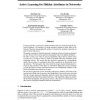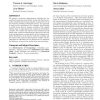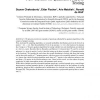64
Voted
CORR
2010
Springer
15 years 28 days ago
2010
Springer
129
click to vote
CORR
2010
Springer
15 years 28 days ago
2010
Springer
We discuss how phase-transitions may be detected in computationally hard problems in the context of anytime algorithms. Treating the computational time, value and utility functions...
123
Voted
CORR
2010
Springer
15 years 28 days ago
2010
Springer
We consider random walks on two classes of random graphs and explore the likely structure of the vacant set viz. the set of unvisited vertices. Let (t) be the subgraph induced by ...
85
Voted
CORR
2010
Springer
15 years 28 days ago
2010
Springer
In many networks, vertices have hidden attributes that are correlated with the network's topology. For instance, in social networks, people are more likely to be friends if t...
104
Voted
CORR
2010
Springer
15 years 28 days ago
2010
Springer
We present a numerical approximation technique for the analysis of continuous-time Markov chains that describe networks of biochemical reactions and play an important role in the ...
40
Voted
CORR
2010
Springer
15 years 28 days ago
2010
Springer
107
click to vote
CORR
2010
Springer
15 years 28 days ago
2010
Springer
We present several new examples of speed-ups obtainable by quantum algorithms in the context of property testing. First, motivated by sampling algorithms, we consider probability d...
83
Voted
CORR
2010
Springer
15 years 28 days ago
2010
Springer
We show that a fast algorithm for the QR factorization of a Toeplitz or Hankel matrix A is weakly stable in the sense that RT R is close to AT A. Thus, when the algorithm is used ...
CORR
2010
Springer
15 years 28 days ago
2010
Springer
Iterative algorithms aimed at solving some problems are discussed. For certain problems, such as finding a common point in the intersection of a finite number of convex sets, there...
98
Voted
CORR
2010
Springer
15 years 28 days ago
2010
Springer
As increasing amounts of sensitive personal information is aggregated into data repositories, it has become important to develop mechanisms for processing the data without revealin...



